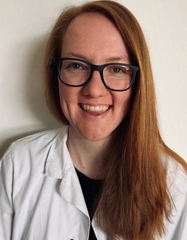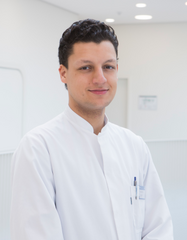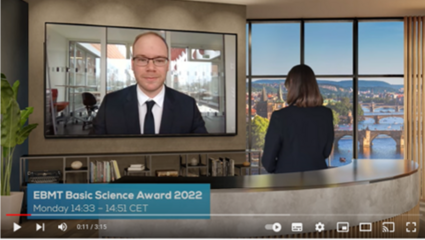PhD students

Technical University of Munich
Klinikum rechts der Isar
Center for Translational Cancer Research (TranslaTUM)
and Department of Internal Medicine II
Supervisor
Ph.D. Markus Tschurtschenthaler (P11)
Description
Colorectal cancer (CRC) consists of diverse routes of carcinogenesis, driven by the loss of tumor suppressor genes, such as Adenomatous Polyposis Coli (APC), or activation of various proto-oncogenes, such as KRAS, BRAF and PIK3CA. Changes in microbiome signatures have been associated with CRC initiation, progression, maintenance and therapy treatment resistance.
We hypothesize that certain subtype-specific mutation patterns may lead to changes in the complex microbiota community the gut. The aims of my project are to decipher genotype-associated microbial taxa and to define bacterial profiles for CRC subtypes. To address these aims, mouse models with intestinal epithelium-specific expression of oncogenic KrasG12D, BrafV637E and Pik3caH1047R or intestinal epithelium-specific loss of the tumor suppressor APC will be used.
We will assess longitudinal microbiome changes during tumor development and tumor progression and compare different environmental settings. Tumor burden, survival rates and molecular patterns of our endogenous mouse models will be compared with genetically identical mice which received an interventional treatment with antibiotics to mimic a “germ-free like” environment. Using orthotopic transplantations of tumor organoids into healthy mice, a highly efficient and elegant tool was established to approximate the human tumor development. We will target commonly CRC-associated genes in our organoids by CRISPR/Cas9 technology, whereby more complex models that recapitulate the whole mutational sequence of different CRC routes can be generated. This transplantation model will be used in the settings of specific pathogen free (SPF) wildtype (WT) and germ-free WT mice as well as in an inflammatory environment.
Collected tumor tissue and paired healthy intestinal tissue will be collected to determine transcriptional profiles and investigate transcriptional epithelial reprogramming. These insights will help us to identify genes that may be regulated by the microbiota. Microbial samples will we be analyzed by 16S rDNA amplicon sequencing and intestinal tissue will be histologically analyzed. Using fluorescence in situ hybridization (FISH) we will be able to validate 16S rDNA sequencing data and to pinpoint bacterial localization.
Targeting Type I-IFN-pathways by bacterial metabolites to prevent inflammatory tissue damage
Technical University of Munich
Klinikum rechts der Isar
Department of Internal Medicine III
Ismaninger-Str. 22, 81675 München
Supervisor
Prof. Dr. Hendrik Poeck (P05)
Sascha Göttert received the 2022 Basic Science Award for a new study looking into how microbial-derived metabolites can induce epithelial recovery through Type-I interferon and limit graft-versus-host-disease.
Impact of exclusive enteral nutrition on microbiome signatures and function in pediatric Crohn’s disease

Technical University of Munich
ZIEL - Institute for Food & Health
Supervisor
Prof. Dr. Dirk Haller (P01)
Description
Crohn’s disease (CD) is one of the two main idiopathic entities of inflammatory bowel diseases (IBD). Genetic susceptibility in combination with compositional and functional changes in the intestinal microbiome are considered to play a key role in the etiology of IBD. Exclusive enteral nutrition (EEN) is a liquid formula-based dietary intervention that efficiently induces remission in active pediatric CD. In previous studies it was shown that EEN treatment is associated with clinical efficacy and microbiome changes in mouse models and patients with CD, but protective mechanisms related to the dietary intervention are unclear. The perspective of this project is to develop a microbiome-based maintenance therapy for pediatric CD patients.
In the current project, we will investigate with gnotobiotic mouse models relevant for IBD and ex-vivo systems the molecular mechanisms and functional relevance of the intestinal microbiome for potential EEN-mediated protection. Therefore, we aim to colonize germ-free mouse models with longitudinal stool microbiota samples from pediatric CD patients with active disease before EEN treatment, inactive disease during EEN, as well as active and inactive disease after the EEN treatment. Tissue pathology and inflammation at the epithelial and immune cell level will be characterized with additional correlation analyses of the host responses with the changes in the microbiome milieu. Followed, several dietary interventions and microbiota treatments will be tested for their potential to induce remission, maintain remission or treat relapse. Transfer experiments in the ex-vivo fermenter system will define the impact of conditioned microbiota indented to a direct dietary exposure. Furthermore, back transfer into the mouse model after ex-vivo dietary modulation will allow to investigate the impact of dietary modulation on the microbiome in a non-host environment.
The impact of Diet and Meal-Timing on the Peripheral Intestinal Clock during Chronic GI-inflammation

Technical University of Munich
ZIEL - Institute for Food & Heatlh
Supervisor
Dr. Silke Kiessling (P03)
Description
Circadian rhythms, fluctuations over 24h in biological processes, control a large part of the human physiology. For example, they control immune function, energy metabolism, digestion and the sleep cycle. Modern lifestyle tends to disrupt these so called circadian rhythms by the more frequent occurrence of shift-work and traveling across time-zones. This circadian disruption is considered to contribute to a large extent to several gastrointestinal (GI) disorders including Inflammatory bowel disorder (IBD) and colorectal cancer. Not surprisingly, since the GI cells undergo circadian rhythms thereby influencing among others, intestinal permeability, cell proliferations and inflammation. Not only the intestinal cells but also the gut microbes undergo rhythmic oscillations in composition and function. The gut microbiome plays an important role in gut homeostasis, influencing immune response, barrier function but also host circadian gene expression. Despite this knowledge, how exactly circadian rhythms of microbial abundance and functioning are altered during GI pathology remains unknown. Moreover, the contribution of diet and meal-timing on the circadian clock during GI diseases and subsequent alterations in oscillating microbial metabolome remains to be investigated. This project will provide important insights into the role of the gut microbiome in circadian physiology during GI pathogenesis both on molecular and physiological levels in vivo and in vitro.
Mechanisms underlying intestinal microbiota orchestrated induction, maintenance andbreaking of tolerance to the non-self-antigen α-Gal in mice and comparison of potential biomarkersand treatment methods to results in human patients

Technical University of Munich
Klinikum rechts der Isar
Department of Dermatology and Allergology
Supervisor
Prof. Dr. med. Tilo Biedermann (P06)
Description
The prevalence of food allergy in developed countries is about 5-8 % and steadily increasing. Recently, for the first time, a new food allergy was identified in humans that is based on a frameshift mutation in the GGTA1 gene leading to inactivated a-1,3-galactosyltransferase 1 (GGTA1). Consequently, in humans and old world monkeys no α-galactose-α-1-3-galactose (α-Gal) can be synthesized. Despite α-Gal being `non-self´, only a minority of the human population suffers from immune side effects such as food allergy upon exposure to α-Gal carrying proteins and lipids. Therefore, immune tolerance must be effective in all α-Gal non-allergic individuals and the breaking of this tolerance is underlying α-Gal based food allergy. The breaking of tolerance is most likely always facilitated by antigen contact via another immune department, the skin, resulting in allergy. In the case of α-Gal-mediated food allergy, it has been shown that tick bites trigger the switch to α-Gal-specific IgE inducing allergy in ~10% of the IgE-sensitized individuals, however and remarkably, ~90% of them remain tolerant to α-Gal demonstrating functional stability of tolerance to α-Gal despite IgE antibodies. Thus, this setting is an ideal model situation, in which induction of stable immune tolerance to α-Gal by α-Gal expressing microbiota can be analyzed. Indeed, the gut microbiota is believed to influence the immune system by regulating immune homeostasis in part through the microbial composition of the intestine. It plays an important role in maturation of the immune system and can regulate autoimmunity as well as Th2 immunity. Moreover, specific microbial compositions are associated with certain health statuses, one of them being ‘allergy’. The introduction of allergy associated microbes into intestines of germfree mice leads to a higher susceptibility to type I allergy. These effects are most relevant very early in life as studies in newborns could distinguish three different microbiota compositions defining a different risk to develop allergy or asthma later in life. Continuous exposure to α-Gal results in permanent active oral immune tolerance.
Our aim is to identify a beneficial microbial composition leading to stable immune tolerance to α-Gal and thereby to resilience to food allergy. As a model, we established food allergy to α-Gal in Ggta1 deficient mice by percutaneous sensitization. Microbiota associated with `allergy´ or `tolerance´ to α-Gal will be characterized and tested for their functional relevance. Among several approaches, one will investigate distinct microbial compositions introduced into germfree α-Gal deficient mice to validate their orchestrating potential in regard to `allergy´ and `tolerance´ towards α-Gal. All our analyses will be compared to results acquired from investigations in a patient cohort of α-Gal allergic and tolerant individuals to transfer findings in to patient care, with the perspective to also interfere with food allergy in humans.
Discovery of carcinogenic small molecules from the intestinal microbiota by direct pathway cloning

Technische Universität Dresden
Faculty of Chemistry and Food Chemistry
Chair of Technical Biochemistry
Supervisor
Prof. Dr. Tobias Gulder (P16)
Description Toxic natural products are believed to play a significant role in the emergence of diseases in the gastrointestinal tract, such as colorectal cancer and inflammatory bowel disease. An example for this is colibactin, which is produced by pathogenic E. coli strains, which were found to correlate to cases of colorectal cancer. The goal of this project is to identify further toxic and/or carcinogenic natural products, in order to better understand those diseases. Therefore, we will collaborate with our project partners, who aim to attain promising biosynthetic gene clusters (BGCs) by bioinformatic analysis. We will clone and heterologously express candidate BGCs by direct pathway cloning (DiPaC). DiPaC is an in vitro method relying on long-amplicon PCR with high-fidelity polymerases and homology-based assembly methods. It allows for refactoring during the cloning step, for example by altering genetic organization or placing transcriptional regulation of the cluster under the control of inducible promotors, such as the ptetO expression system. One of the benefits of DiPaC is the PCR amplification, which can proceed from small amounts of gDNA, potentially even from metagenomics samples. Heterologous production of the natural products can take place in different heterologous hosts, including E. coli BL21/BAP1 and Streptomyces strains. Activity of the cloned BGCs will be tracked by HPLC-analysis of the organic extracts of cell pellets and culture medium. After successful large-scale expression (mg-scale), novel natural products will be isolated by preparative HPLC and analysed with NMR and high-resolution MS, in order to determine the structure. Biological activities will be determined with in vitro experiments and in vivo studies in collaboration with other members of the consortium
T cell characterization in correlation with the intestinal microbiome and GvHD after allogenic stem cell transplantation

Technical University of Munich
TUM School of Medicine
Institute for Medical Microbiology,
Immunology and Hygiene
Supervisor
Prof. Dr. med. Dirk Busch (P04)
Description
Acute GvHD is still the major cause of mortality and morbidity following allogeneic hematopoietic stem cell transplantation (aHSCT). Clinically, it affects skin, liver and gastrointestinal (GI) tract, but GI manifestations drive to a large extent aHSCT-related mortality. Although donor T cell activation by HLA (minor) antigens is in the center of GvHD pathophysiology , mechanisms initiating and promoting inflammation are still not completely understood. In GI-GvHD, a contribution of microbiota has been assumed since the observation that germfree mice are protected from otherwise lethal GvHD and, in light of this, host microbiota decontamination before aHSTC has become a standard clinical approach. Unfortunately, decontamination is hardly achieved whereas a severe loss of microbiota diversity is frequently found. Both experimental and early clinical data clearly demonstrated that this loss associates with an increased severity of GvHD as well as mortality.
Currently, the most direct approach of microbiota modulation is the transfer of healthy donor microbiota by fecal microbiota transfer (FMT). First casuistic reports of FMT in patients with steroid resistant GvHD, which usually show a mortality rate of 70-80%, described resolution of intestinal GvHD in more than 60-70% of the patients. However, the fact that not all patients benefit from FMT suggest that other pathogenic mechanisms have to be unraveled. Recent studies in mice showed a strong impact of microbiota damage on intestinal immune cell populations, specifically regulatory T cells, but a causative link remains to be established. A diverse T cell receptor (TCR) repertoire is needed for a sufficient regulatory milieu able to maintain intestinal homeostasis and the transfer of sorted or in vivo enriched CD4+CD25+ regulatory T cells has shown to suppress GvHD in aHSCT animal models. Thus, rebuilding of protective Treg repertoire appears as a new appealing therapeutic strategy in GvHD patients and it might already be achieved as an indirect effect of FMT treatment; in addition, a combination of Treg-based adoptive cell therapy (ACT) with microbiota diversity restoration could be even more effective.
Our aim is to characterize the immune infiltrate and the TCR repertoire of GI biopsies in GvHD patients and to integrate and correlate this information with microbiota diversity and GvHD clinical outcome. The focus thereby is on regulatory T cells since they have been shown to have some protective capacity in GvHD patients. To reach this aim, two cutting edge technologies will be established to analyze GI biopsies of HSCT patients: the ChipCytometry will enable us to stain up to 100 markers in tissue samples on each single cell whereas single cell RNA sequencing will provide transcriptomic data and the full TCR sequence of individual immune infiltrating cells. The availability of longitudinally collected samples will provide a unique opportunity for investigating how the immune reaction is shaped by microbiota changes and how microbiota related treatments can be optimized in order to prevent GvHD after aHSCT, also in light of the consequent immune system shrinkage. Finally, preliminary data about putative TCR candidates for Treg-based adoptive cell therapy will be generated.
Microbiota – mediated modulation of mucosal immunity

Technical University of Munich
Center of Allergy & Environment (ZAUM)
Supervisor
PD Dr. rer. nat Caspar Ohnmacht (P07)
Description
Colorectal cancer (CRC) consists of diverse routes of carcinogenesis, driven by the loss of tumor suppressor genes, such as Adenomatous Polyposis Coli (APC), or activation of various proto-oncogenes, such as KRAS, BRAF and PIK3CA. Changes in microbiome signatures have been associated with CRC initiation, progression, maintenance and therapy treatment resistance.
We hypothesize that certain subtype-specific mutation patterns may lead to changes in the complex microbiota community the gut. The aims of my project are to decipher genotype-associated microbial taxa and to define bacterial profiles for CRC subtypes. To address these aims, mouse models with intestinal epithelium-specific expression of oncogenic KrasG12D, BrafV637E and Pik3caH1047R or intestinal epithelium-specific loss of the tumor suppressor APC will be used.
We will assess longitudinal microbiome changes during tumor development and tumor progression and compare different environmental settings. Tumor burden, survival rates and molecular patterns of our endogenous mouse models will be compared with genetically identical mice which received an interventional treatment with antibiotics to mimic a “germ-free like” environment. Using orthotopic transplantations of tumor organoids into healthy mice, a highly efficient and elegant tool was established to approximate the human tumor development. We will target commonly CRC-associated genes in our organoids by CRISPR/Cas9 technology, whereby more complex models that recapitulate the whole mutational sequence of different CRC routes can be generated. This transplantation model will be used in the settings of specific pathogen free (SPF) wildtype (WT) and germ-free WT mice as well as in an inflammatory environment.
Collected tumor tissue and paired healthy intestinal tissue will be collected to determine transcriptional profiles and investigate transcriptional epithelial reprogramming. These insights will help us to identify genes that may be regulated by the microbiota. Microbial samples will we be analyzed by 16S rDNA amplicon sequencing and intestinal tissue will be histologically analyzed. Using fluorescence in situ hybridization (FISH) we will be able to validate 16S rDNA sequencing data and to pinpoint bacterial localization.
Microbiota-mediated modulation of the cytotoxic T cell immunity

Technical University of Munich
Chair of Animal Physiology and Immunology
Supervisor
Prof. Dr. med. Dietmar Zehn (P07)
Description
Individuals differ in their susceptibility to infections with the same pathogen and in their ensuing immune response. The complex reasons behind this include genetic predispositions, resistances, the immunological memory and the microbiota. Our project seeks to investigate how alterations in the microbiome influence the outcome of systemic infections. We use the well-established model of infection with lymphocytic choriomeningitis virus (LCMV) to characterise the adaptive immune response of different CD8+ T cell subsets in mice. However, the impact of the intestinal microbiome on the systemic viral infection has not been clarified yet. Moreover, recent studies highlight that outcomes from experiments performed in specific-pathogen free or germ-free mice are not necessarily transferable to complex human diseases.
In our experimental setup, infected mice differ in their microbial compositions ranging from commensal, antibiotic-treated, colonized with defined consortia to germ-free. Studying the intestinal microbiome by high-throughput sequencing as well as metabolite analysis and the antigen-specific cytotoxic T cell reaction by fluorescence-activated cell scanning (FACS) we aim to identify how microbial particularities modulate the adaptive immune response in viral infections. Knowledge of microbial components that alter key aspects of the CD8+ T cell response could be used to improve vaccine efficacy and other therapeutic interventions such as checkpoint inhibition in anti-cancer therapy.
Functional Analysis of the Human Gut Microbiome in the context of Colorectal Cancer

EMBL Heidelberg
Meyerhofstraße 1
69117 Heidelberg
Supervisor
Georg Zeller (P16)
Description
I am developing statistical and computational methods in order to analyse metagenomic data from the human gut microbiome, in order to enable the identification of biosynthetic gene clusters (BGCs). Such clusters encode for proteins leading to the synthesis of natural products (NPs), chemicals which are released into the gut and potentially damage the host. An example of these NPs is colibactin, which have been showed to be a cause colorectal cancer. The long-term objective of my project is to find new candidate NPs that could play a role in the development of diseases such as colorectal cancer, or inflammatory bowel disease.
Spontaneous regression of colon polyps in Familial Adenomatous Polypsis Pig model

Technical University of Munich
Supervisor
Dr. rer. nat. Kondrad Fischer
Prof. Dr. Angelika Schnieke (P06)
Description
Familial Adenomatous Polypsis (FAP) is an inherited predisposition to colorectal cancer (CRC). FAP patients develop multiple colonic adenomas early in life and have greatly increased risk of developing CRC. On the other hand, less than 2 % of small adenoma polyps develop into invasive colorectal carcinoma, the remaining polyps regress spontaneously. We generated APC1311 mutant pigs as a model for FAP. These pigs recapitulate the major hallmarks of the human disease including spontaneous regression of colon polyps. The aim of the project is to systematically elucidate the cellular and microbial interactions that lead to the regression of colon polyps in APC1311 pigs. To this end, we will use a wide range of molecular and immunohistochemical methods to analyze genetic, immunological and microbial alterations in regressive and progressive polyps. Specifically, in order to characterize the immunohistological features of pro/regressing polyps, the H&E, PAS AB and IHC staining will be performed. The genetic variation and gene expression will be analyzed by single cell RNA sequencing and a set of PCR based methods. By combining flow cytometry analysis, FISH and 16S rRNA sequencing, we will investigate the immune and microbiome profile differences between progressing and regressing polyps. It is expected that this project will provide important insights into the interplay of immune cells and the microbiome effect the regression or progression of colon polyps, and provide the basis for therapeutic interventions.
Tailoring bioinformatics algorithms for studying the challenges in microbial data analysis

Technical University of Munich
TUM School of Life Sciences Weihenstephan
Chair of Experimental Bioinformatics
Supervisor
Prof. Dr. Jan Baumbach (INF01)
Description
Recent advances in high throughput sequencing provided a potential way to unravel the role of a microbial community in human health and disease. Several computational pipelines have been developed to characterize the microbiomes and helped to associate microbiome composition and function with healthy and diseases states. However, microbial data analysis comes with many challenges. Profiling of microbiomes and their functions in an accurate manner is still changeling as these depends on several factors such as selecting suitable variable regions, selecting reference databases and addressing compositional nature of data. We are trying to address these challenges with the help of computational methods. We developed a tool, Namco (https://exbio.wzw.tum.de/namco/) with simple and advanced microbial data analysis methods.
Microbial regulation of colorectal cancer

Technical University of Munich
Supervisor
Prof. Dr. med. Sebastian Zeissig (P02, P10)
Description
We have previously shown that microbial factors can regulate intestinal tumor development, for example through activation of TLR (toll-like-receptor)-dependent pathways. In P10, we therefore aim to analyze pathways of microbial control of tumor development and anti-tumor immunity in colorectal cancer (CRC). The translational relevance of preclinical findings in mice will be evaluated using large human CRC cohorts.
Immunophenotyping of immune cells in XIAP-deficiency

Technical University of Munich
Institute of Molecular Immunology and Experimental Oncology
Supervisor
Dr. Monica Yabal (P02)
Description
Intestinal homeostasis results from the complex interplay between epithelial cells, immune cells and intestinal microbiota. A disturbance of any of these components, either due to environmental factors or genetic disposition can lead to varying symptoms, generally summarized as inflammatory bowel disease (IBD).
In contrast to the adult onset classical IBD, children presenting with distinct genetic defects can develop severe early onset IBD, often due to deficiencies in one gene only. We could demonstrate the importance of the so-called X-linked inhibitor of apoptosis protein XIAP for intestinal health, as XIAP-deficient mice display inflammatory symptoms in their terminal ileum, such as villus edema, T cell infiltration and loss of mucus-producing goblet cells. We uncovered dysfunctional epithelial Paneth cells as one contributing factor, failing to carry out their immune-like protective function of the Stem cell compartment located in the intestinal crypts, leading to a breach of the epithelial barrier. Additionally, we could show that a subset of myeloid cDC2 fails to induce tolerance, resulting in sustained TNF-driven inflammatory cell death in XIAP-deficient mice, ultimately failing to maintain a healthy microbiome.
Our future aim is to decipher the molecular basis of programmed cell death signalling in intestinal innate and adaptive immune cell subsets, and their distinct functions in establishing and maintaining the hypoinflammatory environment necessary to mediate intestinal homeostasis based on tolerance towards commensal antigens, leading to a sustained eubiotic microbiome.

Ludwig-Maximilians-Universität München
Faculty of Biology, LMU Biocenter
Großhaderner Str. 2-4, 82152 Planegg-Martinsried
Supervisor
Prof. Dr. Kirsten Jung (P08)
Description
The role of primary metabolites in the intestinal ecosystem under normal and inflamed conditions
This project will investigate the role of primary metabolites, specifically pyruvate, for growth and composition of the intestinal microbiota under normal and inflamed conditions, and furthermore characterize the impact of pyruvate sensing and uptake for gammaproteobacteria in general.
The primary metabolite pyruvate is one of the most important molecules in both pro- and eukaryotes and it was shown that pyruvate is crucial for the virulence of several bacterial pathogens. In this project we will characterize the role of pyruvate sensing and uptake for in the human pathogen Salmonella enterica serovar Typhimurium and also for other members of the intestinal microbiota. An inflammation by Salmonella can lead to perturbations of nutrient availability in the gut and thus to changes in the microbiota composition, for instance an increase of the number of proteobacteria. Therefore, we want to have a closer look at the importance of pyruvate for the intestinal ecosystem both under normal and inflamed conditions.
The first focus will lie on the in vitro investigation of pyruvate sensing and uptake systems of Salmonella enteria and other members of the gut microbiota. In a second step, we will have a look at the impact of my findings in vivo in gnotobiotic mice. We will perform infection experiments and will also have a look at the spatial distribution of the bacteria in the intestinal mucosa and expression of pyruvate sensing and uptake systems there. The overall plan is to carve out the role of pyruvate for the intestinal ecosystem, how pyruvate influences its composition and function and to find out if an inflammation, for example caused by Salmonella, can be affected by pyruvate.
The role of gut microbiota in intestinal lipid absorption and systemic lipid metabolism

Technical University of Munich
ZIEL - Institute for Food & Health
Supervisor
Dr. rer. nat. Josef Ecker (P13)
Description
Variation in dietary fat and gut microbiota affect intestinal lipid resorption (ILR), systemic lipid metabolism (SLM) and energy balance. Excess dietary fat intake promotes positive energy balance, fat accretion and obesity, which is a significant risk factor for colorectal cancer (CRC) associated with significantly altered intestinal lipid profiles. We aim to reveal the role of dietary fat – microbiota interaction on ILR and SLM under physiological and patho-physiological conditions. Based on our previous work in germ-free mice, the dietary fat source, i.e. most likely the cholesterol content, determines diet-induced obesity. Wildtype and Apc1638N germ-free (GF), Oligo-MM and specific pathogen-free (SPF) mice will receive chemically defined diets with varying dietary fat and cholesterol content to determine obesity development, metabolic derangements and intestinal cancer development as well as diet-induced changes of microbiota and lipid metabolism in intestine, blood, liver and adipose tissues. Stable isotope labeled tracers will be applied to track ILR and SLM. To gain mechanistic insights, bioactive lipids (microbiota-, diet- and host-derived) influencing cellular functions either as signaling molecules or through metabolic effects and functional relevant modifications of lipid composition will be analyzed by mass spectrometric methods. These include fatty acid, bile acid and sterol derived metabolites. Promising candidates will be tested for functional relevance. Our study aims to define dietary lipid compositions and gut microbiota communities beneficial in the suppression of obesity-driven metabolic diseases and intestinal cancer.
The Microbial Signatures Database

Technical University of Munich
Supervisor
Dr. rer. nat. Illias Lagkouvardos (INF01)
Dr. PD Klaus Neuhaus
Description
I am working on the Microbial Signatures Database (MSD). The MSD currently provides a standard curated pipeline to decipher microbial diversity based on the 16S rRNA gene sequences powered by a web interface available to store, access, compare and analyze datasets in batches. The MSD benefits the users with its well-defined data structure, standard metadata, and integration of various other data types. I am working to expand the MSD so that it hosts various data types produced in an actual project. The MSD would be a place where researchers can define a project once and have their 16S rRNA, 18S rRNA, ITS, Transcriptomics, Metabolomics, Proteomics, and Metagenomics data readily processed, stored, and managed.
Helicobacter pylori and colon cancer: interplay between microbiome and immune signaling

Technical University of Munich
TUM School of Medicine
Supervisor
Prof. Dr. med. Markus Gerhard (P09)
Description
Helicobacter pylori infection is one of the most prevalent infections worldwide and as the main risk factor for gastric cancer development, has been classified as a WHO class I carcinogen. Although colonizing the stomach, chronic infection leads to systemic consequences. In particular, H. pylori has been recently associated with increased risk for colon cancer, although the mechanisms behind this development remain elusive. We hypothesize that inflammation, disturbances to the intestinal microbiota, and metabolic alterations in response to H. pylori infection, all combine in a multifactorial process to promote the development of colon cancer. Therefore, we will conduct a comprehensive analysis of the immune, microbiome, and metabolome responses elicited by H. pylori infection in mouse models of colon carcinogenesis, in order to identify a risk profile for colon cancer development during H. pylori infection. This risk profile will be validated in a human cohort.
CBM signaling in intestinal immune homeostasis

Technical University of Munich
Klinikum rechts der Isar
Institute of Clinical Chemistry and Pathobiochemistry
Ismaninger Str. 22, 81675 Munich
Supervisor
Prof. Dr. med. Jürgen Ruland (P05)
Description
Coming soon
Dissecting TRIF- and TLR3-mediated signaling in intestinal tumor development

Technical University of Munich
Klinikum rechts der Isar
Department of Surgery
Supervisor
Prof. Klaus-Peter Janssen (P10)
Description
The Toll-like-receptors (TLRs) are part of the innate immune system and mediate the recognition of microbe-associated molecular patterns. Two major adaptors are responsible for signaling downstream of the TLRs: TRIF and MyD88. Apart from TLR3, all TLRs signal through MyD88, activating the NF-κB pathway and pro-inflammatory programs. In contrast, the endosomal receptor TLR3 solely relies on TRIF (encoded by the TICAM1 gene) to activate its effector functions. TLR3 recognizes dsRNA from viruses, necrotic host cells, and non-pathogenic lactic acid bacteria, which were shown to induce TLR3-mediated cytokine production from murine and human innate immune cells. For colorectal cancer (CRC), our group could show that MyD88- pathway activation is associated with poor post-operative prognosis and that MyD88 has tumor promoting effects in vivo. However, the role of TLR3 in CRC however is not clear yet.
We were able to show that TLR3- dependent chemokines are associated with positive prognosis and T cell infiltration in CRC, as well as with the presence of specific bacteria. In clinical samples of CRC, as well as in genetic mouse models (Apc1638N/+), the intratumoral expression of TLR3 was significantly decreased, and correlated with poor prognosis. Furthermore, mouse models with deficiency in either Tlr3 or Trif showed significantly more intestinal tumors.
Based on previous work, we thus hypothesize that TLR3 and TRIF have tumor suppressive effects in CRC. Further, we predict that these putative beneficial effects are caused by stimulation of TLR3/TRIF through ligands derived from specific microbial taxa. The underlying mechanisms and the contribution of microbiota will be investigated by using in vitro models, as well as newly developed “switch on mutagenesis” genetic mouse models for tissue-specific expression of Tlr3 and Trif, and in a translational approach, in clinical samples.
Cancer cell-intrinsic effects (e.g. induction of cell death, effects on migration and invasion) and cancer cell-extrinsic effects (e.g. production of cytokines and effects on immune cells) will be compared using established colon cancer cell lines with a CRISPR-Cas9 mediated gene deficiency and the genetic mouse model. Unbiased RNA sequencing of TLR3 deficient cell lines and tumor tissue samples will be conducted to investigate transcriptome-wide alterations related to TLR3 function, focusing on alterations in downstream signaling of TLR3, such as IRF3 and IRF7 target gene activation. Putative host-induced alterations of the microbial communities will be analyzed by 16S rRNA sequencing of luminal and tissue adherent microbiota from Tlr3 deficient and proficient tumor-bearing mice as well as in mice with a tissue-specific re-expression of Tlr3.
Impact of exclusive enteral nutrition on microbiome signatures and function in pediatric Crohn’s disease

Ludwig-Maximilians-Universität München
Div. Pediatric Gastroenterology and Hepatology
Supervisor
Dr. med. Tobias Schwerd (P01)
Description
Crohn’s disease (CD) is one of the two major entities of inflammatory bowel disease (IBD) with a rising incidence in industrialized countries. Episodes of remission and relapse characterize the disorder and symptoms include abdominal pain, fever and diarrhea. The etiology of CD is multifactorial and based on dysregulated interactions between the immune system, the intestinal microbiome and additional environmental factors (e.g. westernized diet) in genetically susceptible individuals. No curative treatment is currently available for IBD.
Exclusive enteral nutrition (EEN) is the first line therapy for active pediatric CD. EEN is a liquid formula-based dietary intervention, which effectively induces remission and mucosal healing. Compared to standard immunosuppressive treatments, EEN has almost no related side effects. Yet, the protective and remission inducing mechanisms behind this dietary therapy remain unclear. Of note, previous studies have shown a substantial change in the microbiome composition during EEN, but a causal relationship for microbiota changes and mucosal healing has not been established.
The aim of this project is to understand the role of changes in microbiota composition and/or function for the success of EEN in pediatric CD. In addition, we aim to gain further insight in the complex interactions between diet, microbiome and the intestinal immune system.
To reach our goals, we conduct an open label study at Dr. von Hauner Children’s Hospital and longitudinally follow CD patients treated with EEN. We prospectively collect biomaterials and analyze changes in the microbiome, the metabolome and the immune system related to EEN-mediated resolution of inflammation. On the long run, we will use this knowledge to develop a maintenance therapy based on EEN-conditioned microbiome and/or metabolites in order to improve long-term remission in pediatric CD patients.
The impact of cholesterol-rich high fat diets on gut microbiota species and host energy metabolism

Technical University of Munich
ZIEL - Institute for Food & Health
Supervisor
Prof. Dr. Martin Klingenspor (P13)
Description
Obesity is an emerging health issue in the western population mostly accredited to excess dietary fat intake, promoting a positive energy balance. The gut microbiota thereby plays an important role, affecting intestinal lipid resorption (ILR), systemic lipid metabolism (SLM) and the energy balance of the host. Additionally, obesity is regarded as a major risk factor for the development of colorectal cancer (CRC), which is associated with significantly altered intestinal lipid profiles and shifts in microbiota populations in the gut.
The aim of our study is to investigate the role of dietary fat – microbiota interaction on the energy balance of the host, ILR and SLM under physiological and patho-physiological conditions. Our previous research strongly suggests that in germ free mice the dietary fat source, in specific most likely the cholesterol content, determines diet-induced obesity. To determine metabolic derangement, obesity development and intestinal cancer progression as well as diet-induced obesity wildtype (C57Bl/6N) mice and a mouse tumor model (Apc1638N) will receive chemically defined diets with varying dietary fat and cholesterol content. In this setup, we will investigate the changes of microbiota and lipid metabolism in intestine, blood, liver and adipose tissue. For the tracking of ILR and SLM, stable isotope labeled tracers will be applied. To gain mechanistic insights, bioactive lipids (microbiota-, diet- and host-derived), influencing cellular function either as signaling molecules or through metabolic effects and functional relevant modifications of lipid composition, will be analyzed by mass spectrometric methods. Candidate bioactive species include fatty acids and sterol derived metabolites.
By combining these mechanistic approaches, we intend to find promising candidates, which will be tested for their functional relevance. Our goal is to identify dietary lipid compositions and gut microbiota communities beneficial for the suppression of obesity-driven metabolic diseases and intestinal cancer and thus could be used in pre- and probiotic models.
Targeted analysis of bacteria and phage diversity for tailored manipulation of a minimal consortium

Ludwig-Maximilians-Universität München
Max von Pettenkofer-Institute for Hygiene and Clinical Microbiology
Supervisor
Prof. Dr. rer. nat. Barbara Stecher (P14)
Description
Phages are among the most abundant microbes in the gut, but also among the least understood. We want to investigate their role in the ecology of the microbiome and their influence on bacterial communities. To simulate natural conditions like the complex microbiome in the gut, we use a minimal bacterial consortium, the Oligo-MM12, which provides resistance against the human enteric pathogen Salmonella enterica. Furthermore, this minimal bacterial consortium represents a multipurpose tool to explore the contribution of individual bacteria and their functions to microbiota-related phenotypes such as bile acid modification as well as the effect of strain-specific phages.
Phages can be a powerful tool for microbiome-directed therapies, like elimination of potentially harmful bacteria or supporting probiotic bacteria by generating niche space in the gut. In this project, we want to find strain-specific phages to observe their role on the Oligo-MM, regarding changes in the community and ecology of the bacteria. Furthermore, we want to find specific phages for bile-acid converting bacteria like Extibacter muris, to investigate the changes in the bile acid metabolism, both in vitro and in vivo. This project will yield insights into the ecological importance of phages in the gut, which will be important for evaluating the future use of phages for targeted microbiome manipulation.
Virome signature in gastrointestinal tract

Helmholtz Zentrum München
German Research Center for Environmental Health (GmbH)
Institute of Virology
Ingolstädter Landstraße 1
85764 Neuherberg
Supervisor
Dr. Li Deng (P09)
Description
From a therapeutic perspective, it is extremely difficult to tackle subtle dysbiotic changes caused by infection of bacteria such as Helicobacter pylori in the background of rising antibiotic resistance, the side effects of virtually all antibiotics on the microbiome itself, and the lack of highly specific/selective therapeutic agents. Phage therapy utilizes viruses of bacteria (bacteriophages) or phage-derived inhibitors as natural ways to fight pathogenic bacteria, and might also be feasible to address pathobionts. Phages are host-specific meaning they are highly selective in their host choice.
The main obstacles in the clinical application of phage-based therapy are the limited number of phage isolates currently available, and the unknown molecular mechanisms of phage-delivered bactericidal action. Phages are the most abundant entity on Earth and can be found in every ecosystem. Although they are widely distributed only a few have been isolated yet. The isolation process has not changed since its discovery in the early 1900s. It is laborious, time-consuming, and difficult due to certain phage properties. In our project, we want to develop a high-throughput screening method specifically targeting therapeutically suitable phages to expand the phage collection. By applying single-phage-viral- tagging with a subsequent targeted amplification step, we aim to achieve a much-improved detection efficiency. Building on these high-throughput, culture-independent but host-targeted methodologies, within the first funding period we will screen for all possible phages on gastrointestinal pathogens or pathobionts relevant for colon carcinogenesis. We will characterize phage-specific inhibition modes in order to elucidate the molecular mechanisms driving phage-mediated inhibition of the selected pathogenic bacteria.
Furthermore, the newly developed method will be applied to investigate the virome (total viral community) signature of the gastrointestinal tract. It is known that bacteriophages play a key role in microbial communities and are the leading cause of bacterial mortality. Since the communal microbe composition changes within a diseased state and continues to alter during disease progression, we hypothesize that the changes of virome diversity will correlate with this. Analyzing the viral content under disease conditions and at various disease stages will shed light on the phage-host interactions and their impact on the overall microbial complex.
Elucidating the mechanism intestinal inflammation and dysbiosis in XLP2-disease

Technical University of Munich
Klinikum recht der Isar
Medizinische Klinik und Poliklinik III - Hämatologie/Onkologie MD
Supervisor
Prof. Dr. Florian Bassermann
Mentors
Univ.-Prof. Dr. med. Philipp Jost
Univ.-Prof. Dr. med. Roland Schmid (Z02)
Description
A major cause of very-early onset inflammatory bowel disease (IBD) are primary immune-deficiencies (PID). One example is the X-linked lymphoproliferative syndrome type 2 (XLP2) that is caused by deficiency in the X-linked inhibitor of apoptosis protein (XIAP). XLP2 patients present with a plethora of symptoms that include hemophagocytic lymphohistiocytosis (HLH), recurrent splenomegaly and therapy refractory IBD which affects 20-26% of XLP2 patients. Although many symptoms of XIAP-Deficiency have been associated with Epstein-Barr virus and other infections, the trigger behind the development of IBD remains elusive. Our goal is to identify the molecular mechanism behind intestinal inflammation and dysbiosis in XLP2-Disease using gene targeted mouse models. Preliminary data suggest Xiap–/– mice develop a mild terminal ileitis which is triggered by microbiota and amplified by TNF-dependent signaling. We will aim to decipher these events trying to understand how aberrant TNF-mediated inflammation and RIPK3 dependent cell death are driving intestinal inflammation and dysbiosis in the absence of XIAP.
Mechanisms underlying intestinal microbiome orchestrated induction, maintenance and breaking of tolerance to non-self-antigens

Technical University of Munich
ZIEL - Institute for Food & Health
Supervisor
Prof. Schnieke, Angelika (P06)
Description
Red meat allergy has been associated with two distinct forms of anaphylaxis: i) immediate onset anaphylaxis during first exposure to cetuximab, and ii) delayed onset anaphylaxis after ingestion of mammalian food products (e.g., beef and pork). The current hypothesis is that people are bitten by ticks. Following a period, IgE to alpha-gal develops. Once IgE to alpha-gal reaches sufficient levels, ingestion of red meat can trigger reactions. The characteristics of red meat allergy are different from typical allergic reactions which always delayed for 2–6 hours or even longer. The most common symptom reported was itching. Human naturally lack a-gal due to inactivation of the GGTA1 gene. Our investigation will involve GGTA-1 KO pigs.
Gut microbiota composition plays an important role in organ integrity and disease development. It is involved in the induction and maintenance of immune tolerance, inflammation and allergy development. Metabolites produced by gut microbiota can stimulate intestinal mucosa to synthesize thymic stromal lymphopoietin, TGF-β, retinoic acid and increase tolerance type DC and Treg cells are produced to induce tolerance. The current research results of Professor Schnieke's team show that homozygous GGTA1-KO pigs can produce antibodies against α-Gal due to gene inactivation, but the intestinal tract still produces natural tolerance and does not cause food allergies. Through sequencing, it was found that the gut microbiota contains a higher proportion of proteobacteria expressing α-Gal. Therefore, in this topic, we deeply study the role of gut microbiota in maintaining and destroying oral tolerance.
In the current project, we are aiming to analyze different aspects of the skin barrier system controlling tolerance damage, which may be involved in food allergy development. In addition we intend to understand whether the Colonisation with a-Gal containing microbiota strength the oral tolerance. Above all can increase the possibility of manipulating the microbiota fluctuations to attenuate the food allergy.
The role of primary metabolites in the intestinal ecosystem under normal and inflamed conditions

Ludwig-Maximilians-Universität München
Max von Pettenkofer-Institute for Hygiene and Clinical Microbiology
Supervisor
Prof. Dr. Barbara Stecher (P08)
Description
The composition of the gastrointestinal microbiota is not only determined by stochastic processes such as dispersal or ecological drift, but is strongly influenced by deterministic interactions between species and the individual host environment. In the healthy gut, the enteric microbial community faces frequent changes in the availability of nutrients. The source of metabolites varies in space and time with dietary composition, as well as with host-dependent factors. Especially inflammatory processes can create metabolic niches in the gut that may affect the composition and function of the microbial ecosystem.
Therefore, in the dynamic chemical environment of the mammalian gut, antagonistic interactions, such as substrate competition, as well as beneficial interactions shape the composition of the enteric microbiota. A prime example for the latter is metabolic cross-feeding between individual species. Cross-feeding leads to formation of metabolic networks in the community, and increases metabolic output. As metabolic interactions occur between a multitude of species, creating heuristics to identify the nature and complexity of interactions based on phylogeny only is challenging. To understand and predict the assembly and function of complex microbial communities, a more mechanistic knowledge of metabolic interactions is needed.
In the current project, we will investigate the role of primary gut luminal metabolites, specifically short chain fatty acids and pyruvate, in a defined subset of community members and in gnotobiotic mouse models, as well as mouse models of gut inflammation, using growth and metabolome profiling approaches. By that, we aim to gain a better understanding of the spatial, temporal and compositional complexity of ecological and metabolic microbial community interactions in the mammalian gut. Most interestingly, especially pyruvate plays an important role in both prokaryotes and eukaryotes, as it not only forms the hub between aerobic and anaerobic metabolism, but further acts as scavenger for reactive oxygen species. Recently, a two-component system for pyruvate sensing and transport was discovered in the human enteric pathogen Salmonella enterica serovar Typhimurium. Therefore, we aim to characterize the impact of pyruvate sensing and uptake on fitness and growth of S. Typhimurium and the individual species of a defined microbiota consortium in vitro and in vivo.
Porcine models for intestinal diseases

Technical University of Munich
TUM School of Life Sciences Weihenstephan
Chair of Livestock Biotechnogloy
ZIEL - Institute for Food & Health
Supervisor
Prof. Ph.D. Angelika Schnieke (P06)
Description
Crohn’s disease (CD) is a chronic idiopathic inflammatory bowel disease (IBD) characterized by skip lesions and transmural inflammation that can affect the entire GI tract, but in most cases is restricted to the terminal ileum and colon (Kontoyiannis et al., 1999; Feuerstein et al., 2017). The prevalence of CD has an annual incidence of 3 to 20 cases per 100.000 with a higher prevalence in the industrialized world. It is a multifactorial illness of yet not fully understood etiology. Besides genetic and environmental factors, immune dysregulation plays a significant role in CD-pathogenesis with patients showing an elevated production of the Th1 cytokines IL-2, IFN-y and TNF-a (Huybers et al., 2008). It was shown that CD involves complex interactions among the host immune system, intestinal mucosa and gut microbiota, where an excessive immunity or immune imbalance of gut symbiotic bacteria in CD patients can lead to mucosal injury. For instance, the differentiation of pro-inflammatory Th17- cells is induced by the presence of segmented filamentous bacteria (SFB) within the intestinal microflora, thus affecting the severity of gastrointestinal inflammation. The abnormal microbiota furthermore reduces the complexity which is one of the common features of patients suffering from IBD. This leads to decreased short chain fatty acid (SCFA)-synthesis, thereby affecting the anti-inflammatory and immune regulatory role of this metabolite (Shen et al., 2017; Vinolo et al., 2011).
A rodent model for CD is the TNF-aDARE/+ mouse (Kontoyiannis et al. 1999), which has a 69 bp deletion in the 3’ untranslated region (UTR) of the TNF-a gene, including an AU-rich element (ARE). AREs negatively regulate mRNA stability and translation through post-transcriptional control of mRNA export, cytoplasmic exosomal degradation of the mRNA and translational inhibition (Stoecklin et al., 2002). In TNF-aDARE/+ mutant mice it leads to elevated levels of TNF-a, resulting in CD, with a more severe phenotype in homozygous TNF-aDARE/DARE animals.
While mice are a great animal model for basic research, the pig has been proposed as a more relevant model for translational research, based on its similarity with humans in body size, anatomy, and their physiological and pathophysiological responses. Also, pigs and humans both are omnivores, they have a similar neonatal gut development and gastrointestinal immunologic responses. Until today, numerous genetically modified pig models for biomedical purposes have already been generated (Flisikowska, 2014).
The goal of the project presented here is to generate and characterize a porcine model for CD based on the TNF-aDARE mouse model and to assess the influence of the microbiome on disease progression or as a therapeutic agent. To delete the ARE sequence, genome editing will be carried out in in vitro produced embryos followed by embryo transfer into surrogate mother sows. Tissue samples from piglets will be used to determine their genotype, correctly modified animals will be used for breeding and to determine their phenotype. If it reflects the human CD pathophenotype then follow up experiments in order determine the influence of the intestinal microbiome will be carried out. Finally, defined bacterial consortia which negatively or positively influence pathogenesis of CD might be identified, with the ultimate goal of finding new therapeutic treatment strategies.

University Hospital of RWTH Aachen
Institute of Medical Microbiology
Functional Microbiome Research Group
Pauwelsstr. 30, 52074 Aachen
Supervisor
Prof. Dr. rer. nat. Thomas Clavel (P14)
Dynamics within bile acid-metabolizing bacterial communities
Bile acids regulate a plethora of inflammatory and metabolic pathways. They also exert bacteriostatic effects, and the gut microbiota plays a major role in modulating their bioavailability. However, knowledge about specific gut bacteria that metabolize bile acids is still incomplete and there is very little experimental proof of the functional role of secondary bile acids in chronic diseases. In this project, we will use culture, molecular, and gnotobiotic approaches to investigate the microbial ecology of bile acids. The aims are to explore the unknown diversity of bile-acid converting bacteria and the impact of community dynamics and diet on bile metabolite fluxes. Defined minimal consortia of mouse gut bacteria able to catalyse specific bile-acid modifications will be assembled and studied in vitro (continuous culture) and in vivo (gnotobiotic models), combined with microbiota composition analysis and metabolite profiling.
Microbiome-Immune cell interactions

Translational cancer research and experimental cancer therapy
TranslaTUM
Einsteinstraße 25 (Building 522)
81675 Munich
Supervisor
Dieter Saur (P12)
Roland Rad
Marc Schmidt-Supprian
Description
Inflammatory signals induced by tumor cells or the host environment are closely linked to cancer progression and treatment resistance. Our preliminary data suggest that the mutational make-up of the primary tumor dictates the pro- and anti-tumorigenic immune response, which in turn determines tumor progression and survival. However, the underlying context specific cellular and molecular mechanisms and the functional relevance of the cross-talk between tumor cells and their pro-inflammatory microenvironment remain unclear. We aim to systematically decipher inflammatory pathways in subtypes of intestinal cancer and to evaluate the contribution of different immune cell subsets to cancer initiation and progression. We will generate novel triple-recombinase models, which can be used to genetically manipulate immune cell subpopulations independently of the oncogenic driver. This will allow us to dissect inflammatory nodes to discover novel therapeutic approaches for intestinal cancer subtypes.
